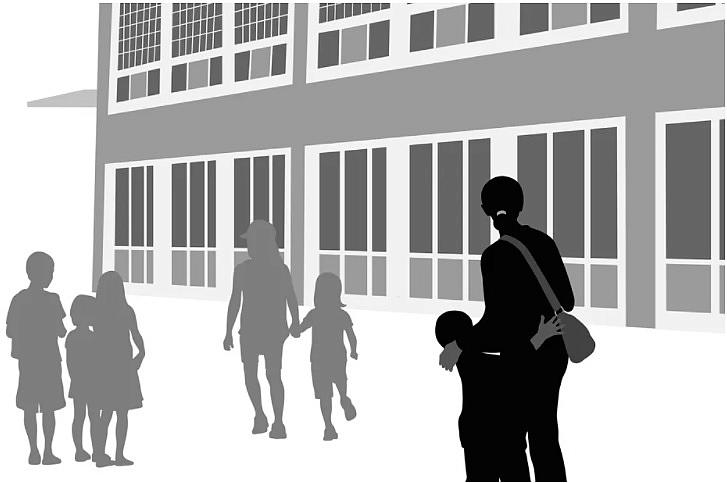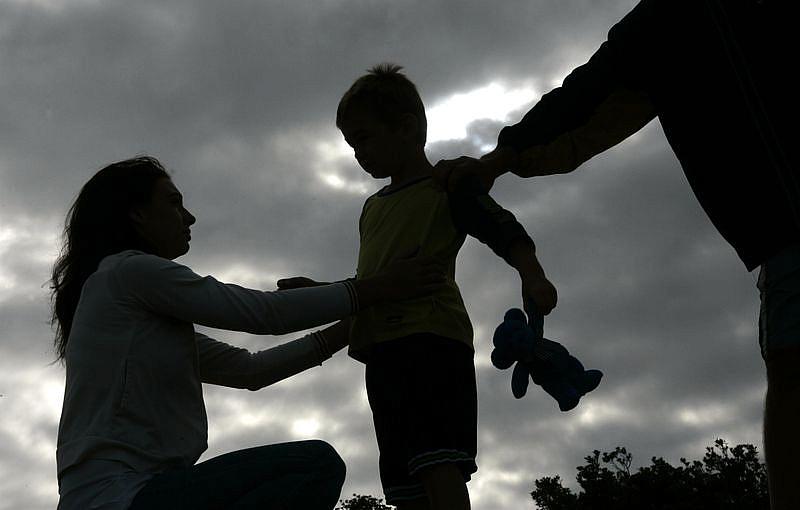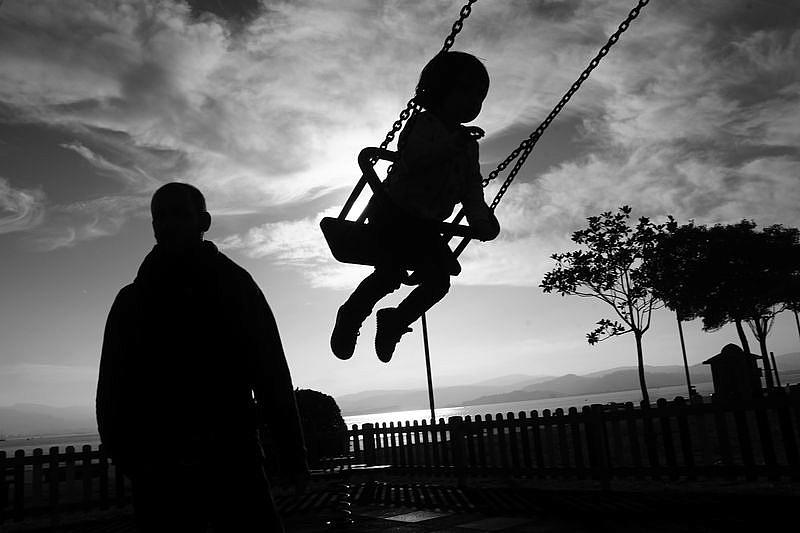What happens to a family when they have equal rights, and then lose them?
Dara Lind, a 2017 National Fellow, reported this story with the support of the Fund for Journalism on Child Well-Being, a program of the USC Annenberg Center for Health Journalism.

A-Digit via Getty Images
DENVER — “You really don’t realize how much your kids pay attention when adults are talking,” Treisi Martinez, a 25-year-old mother of two who is protected temporarily from deportation through the Deferred Action for Childhood Arrivals program, told me in October.
Martinez’s oldest daughter is 5. That’s old enough to ask heartbreaking questions, like why her mother isn’t coming with the rest of the family to visit relatives in Juarez. But it’s too young, her mother judges, to be able to handle the answer: that while Martinez’s husband is a citizen and their daughters, the younger of whom is 6 months old, were born in the United States, Martinez is still waiting on a green card application.
If Martinez has to go back to Mexico, it wouldn’t be for a visit. It would be forever. She doesn’t think her daughter is ready to hear that.
Martinez says her daughter, seemingly engrossed in Dragon Tales or Sofia the First, will absorb the tense conversations among adults and ask, “Mom, why does no one like Trump? Is he really going to send a lot of people away?”
“She was watching Netflix on her iPad,” Martinez, who is one of the estimated 200,000 DACA recipients with US-born children, says. “But really, she was listening to everything.”
The Trump administration began phasing out DACA in September. Congress remains divided over whether and how to address the status of the 690,000 DACA recipients; at the moment, it’s really a fight about how urgent a priority it is. Republicans would rather put off dealing with the problem until March 5 “deadline” given by Trump in September. Democrats, realizing the only leverage they have is during spending fights, want something done before the end of the year. They point out that as many as 122 DACA recipients are losing their protections each day, totaling as many as 22,000 by the time that March deadline rolls around.
In the meantime, thousands are living with a wrenching uncertainty. Uncertainty over whether their renewal applications will be accepted; uncertainty over whether they can sign leases or enroll for another school year; uncertainty in knowing that their days working legally and living securely in the US are numbered; uncertainty that their US-born children could find out how tenuous their parents’ presence is.
For many DACA recipients who have US-born children, the struggle against fear is both simple and impossible: They want, desperately, to protect their children from worrying about something they cannot control. DACA recipients are trying to plan for the worst, while hoping they’ll never have to speak those plans to their children aloud.
“You had a taste of what it’s like to have equal rights”
Maria Guerrero’s work permit isn’t set to expire until 2019. But for two months in 2015, when her first work permit under DACA expired before her second one had come through, she got a taste of what life without protection would be like.
Guerrero was like many unauthorized immigrants who came to the US as children and didn’t find out the truth about their immigration status until they were a teenager. “I thought everyone was the same,” she says wistfully. “My world was so tiny.”
When her friends started getting driving permits, she pestered her father to take her to the DMV so she could get hers too. He put her off for a while by promising to do it on his next day off (“he never had a day off”), but when the day finally arrived, “I think he was just like, ‘Okay, we’re done beating around the bush, you need to know.’”
In the years since the DREAM Act was first introduced in 2003, politicians have drawn a sharp line between Guerrero’s father’s generation of unauthorized immigrants, who came to the US as adults, and the children, like Guerrero, they brought with them. To many supporters of the DREAM Act, immigrants like Guerrero were blameless, and it was unfair to keep them in the shadows because of the “sins of their parents.”
Fairfax Media via Getty Images
After 15 years of debate, though, nothing permanent has been done, and a generation of DREAMers has grown up and had children of their own. Instead of their parents being responsible for their misfortune, DACA recipients are now the ones whose unauthorized status could end up jeopardizing their children’s lives.
Guerrero has a full-time job with a community organizing group. She has children of her own now, 4 and 2 years old, and two nieces and a nephew she often gets charged with taking care of too. All five were born in the US.
Her DACA protection lapsed while she was pregnant with her second child, and she was suddenly returned to the world of her childhood, in which the family’s movements were closely circumscribed. “We would be usually at the house every day except either Saturday or Sunday,” she recalls, afraid to go out.
Her father, who works in construction, always requests to be excluded from airport projects because “he’s terrified of federal places. He does not like courts, does not like airports, does not like really public places” — though with his children now grown, he’s gotten over his fear of flea markets.
Now that she has children, she gets it. “I was like, this is what my parents felt.”
Guerrero tried to hold off the HR office at Walmart asking her if she’d gotten her new work permit yet, but ultimately got “pulled out.” Instead, she grabbed shifts here and there, waitressing and telemarketing — for far less than the minimum wage she was accustomed to as a legal employee.
“In a way, you’re grateful that somebody’s giving you the opportunity to have some income,” she says in October. “But then on another side, you had a taste of what it’s like to have equal rights.”
There’s evidence that the “taste of equal rights” DACA provided was absorbed into the bodies and minds of recipients and their children alike. One Harvard study found that immigrants who were eligible for DACA reported better mental health after the program’s enactment, in 2012, while those who weren’t eligible reported no change.
Meanwhile, a study of Medicaid recipients in Oregon led by Stanford researchers found that children of DACA-eligible mothers were diagnosed with attachment and anxiety disorders at much lower rates from 2013 to 2015 than children of immigrants too old to qualify for DACA (which wasn’t available to immigrants who were born before June 1982). Before DACA came around, there was no difference between the groups; afterward, attachment and anxiety disorders were detected in 7.8 percent of children of DACA-ineligible mothers, and only 3.3 percent of children whose mothers qualified for protection.
There aren’t any studies about what happens after losing DACA. There isn’t any precedent for it.
The fight to keep children fearless
When the Trump administration announced DACA’s end in September, Guerrero held herself together through dinner with her family. “I’m the older sister, so I felt like, ‘Oh, you need to be the strong one,’” she says. “I feel like if I freaked out at that point, everybody’s gonna freak out.”
She put her children to bed. When the girls were asleep, Guerrero allowed herself to start crying again. She looked around the room, trying to reassure herself that she’d be able to put food on the table even without a minimum wage job. “We can just sell everything, we’re not born with things,” she recalls telling herself. “Once you stop working, you’re going to hit a point where you can’t pay insurance — then what’s the point of having the car?”
Luckily for Guerrero, 4 years old is too young even to ask those heartbreaking questions. And even though Treisi Martinez’s 5-year-old seems to overhear everything, Martinez still hasn’t burdened her with the full truth.
Amaia Arozena & Gotzon Iraola/Getty Images
“It would break my heart, and I know it would break hers. If I need to, I will tell her then.”
But Martinez knows that she can’t insulate her daughter from awareness of the wider world forever — and maybe not all that long at all. Children talk to each other and hear snippets of news stories, and when they’re older they see Facebook posts about ICE checkpoints and cellphone videos of fathers being taken away.
Martinez herself works as an office administrator at her daughter’s elementary school. She’s been approached in the middle of the school day at her desk by students not much older than her daughter, wracked with sudden anxiety that their parents won’t be there when they come home. She’s helped them call their parents from the school’s front office phone, to hear their parents’ voices and the reassurances it’s going to be okay.
Martinez doesn’t want that for her daughter. “All she’d be doing is not paying attention in school, and worrying all the time.” She knows that future because she sees it in other kids. In the Oregon Medicaid study, the average age at which children of unauthorized immigrant mothers were diagnosed with attachment or anxiety disorders was around 6 and a half.
If Martinez worries her daughter is too fragile to handle the fear of separation — she’s already “really attached to us,” she says — Guerrero wants to protect her daughters for the opposite reason.
“They are fearless,” she says. “I look up to them. They don’t even know what’s going to happen right after they do something, but they do it if they want to do it. I need to do that.”
Sometimes, she allows, they’ll pretend to be scared of el cucuy — a folk monster, a boogeyman. “I’m like, monsters are scared of you guys. I feel like they would pull on its hair or horns or whatever, cling onto its feet.”
It’s getting late in Guerrero’s basement apartment, and the children are getting hyper with fatigue. Guerrero’s 2-year-old daughter rushes my legs, growling in play ferocity — but she’s grinning, with the confidence of someone who’s never met something she couldn’t face down.
“I can’t even imagine them understanding how complicated it is,” Guerrero had mused earlier. After all, she herself didn’t fully understand that fear until she became a mother. She hopes that’s an understanding her children will never need to have. But it will take action from Congress to break the cycle.
[This story was originally published by Vox.]
